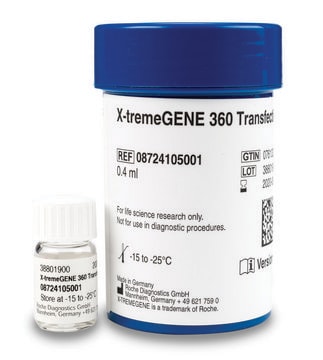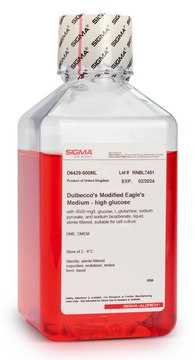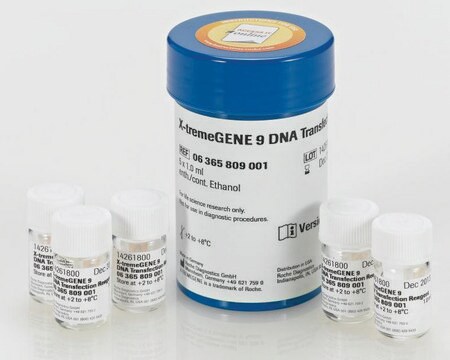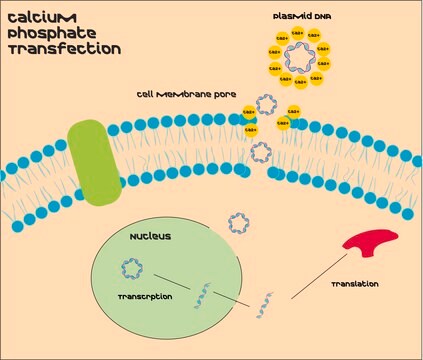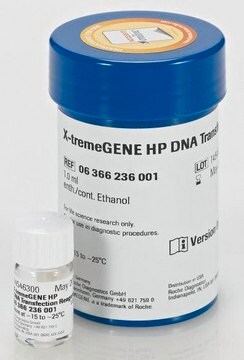N2913
Sistema de transfección N-TER™ nanopartículas con siRNA
Iniciar sesiónpara Ver la Fijación de precios por contrato y de la organización
About This Item
Código UNSPSC:
12352200
NACRES:
NA.51
Productos recomendados
Formulario
liquid
Condiciones de envío
wet ice
temp. de almacenamiento
−20°C
Aplicación
The N-TER Nanoparticle siRNA Transfection System is a peptide-based system for use in the transient knockdown of eukaryotic gene expression. The N-TER Peptide binds siRNAs non-covalently, forming a nanoparticle. This nanoparticle interacts directly with lipids on the surface of the plasma membrane, allowing the nanoparticle to diffuse across the cell membrane and deliver the siRNA directly to the cytoplasm. Unlike most lipid-based transfection methods, this novel delivery mechanism bypasses the endosomal pathway, eliminating possible compartmentalization and degradation of the siRNA.
Información legal
Manufactured and Distributed by Sigma-Aldrich, under license from the CNRS.
N-TER is a trademark of Sigma-Aldrich Co. LLC
Código de clase de almacenamiento
12 - Non Combustible Liquids
Clase de riesgo para el agua (WGK)
nwg
Punto de inflamabilidad (°F)
Not applicable
Punto de inflamabilidad (°C)
Not applicable
Elija entre una de las versiones más recientes:
¿Ya tiene este producto?
Encuentre la documentación para los productos que ha comprado recientemente en la Biblioteca de documentos.
Los clientes también vieron
Federica Simeoni et al.
Nucleic acids research, 31(11), 2717-2724 (2003-05-29)
The improvement of non-viral-based gene delivery systems is of prime importance for the future of gene and antisense therapies. We have previously described a peptide-based gene delivery system, MPG, derived from the fusion peptide domain of HIV-1 gp41 protein and
L Crombez et al.
Biochemical Society transactions, 35(Pt 1), 44-46 (2007-01-20)
The major obstacle to clinical development of siRNAs (short interfering RNAs), like for most of the nucleic-acid-based strategies, is their poor cellular uptake and bioavailability. Although several viral and non-viral strategies have been proposed to improve siRNA delivery, their applications
Sébastien Deshayes et al.
Advanced drug delivery reviews, 60(4-5), 537-547 (2007-11-27)
The recent discovery of new potent therapeutic molecules which do not reach the clinic due to poor delivery and low bioavailability have made of delivery a key stone in therapeutic development. Several technologies have been designed to improve cellular uptake
Linlu Tian et al.
Scientific reports, 5, 12357-12357 (2015-07-24)
Melanoma is one of the most aggressive skin cancers and is well known for its high metastatic rate. Studies have shown that epithelial mesenchymal transition (EMT) is essential for melanoma cell metastasis. However, the molecular mechanisms underlying EMT are still
Joshua E Lewis et al.
Antioxidants & redox signaling, 29(10), 937-952 (2017-08-02)
The purpose of this study was to investigate differential nicotinamide adenine dinucleotide phosphate, reduced (NADPH) production between radiation-sensitive and -resistant head and neck squamous cell carcinoma (HNSCC) cell lines and whether these differences are predictive of sensitivity to the chemotherapeutic
Artículos
This discussion will highlight some of these methodologies, namely, the use of Multiple Reaction Monitoring (MRM) and Protein-AQUA.
Nuestro equipo de científicos tiene experiencia en todas las áreas de investigación: Ciencias de la vida, Ciencia de los materiales, Síntesis química, Cromatografía, Analítica y muchas otras.
Póngase en contacto con el Servicio técnico